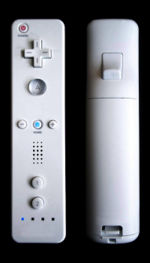PC Wiimote control


The Wiimote is quite a sophisticated device internally. According to Wikipedia and manufacturer information it contains an ADI ADXL330 3-axis iMEMS accelerometer:
The ADXL330 is used to sense motion of the game player in three dimensions of freedom: forward-backward, left-right, and up-down. When the new controller is picked up and manipulated, it provides a quick element of interaction, sensing motion, depth and positioning dictated by the acceleration of the controller itself.
If that weren't enough, the front of the Wiimote houses a tiny one-megapixel camera that constantly looks for the ten tiny IR lights in the Wii's sensor bar, and uses those to figure out exactly where you're pointing the remote. Unlike traditional light guns (which rely on special patterns on the display), this point could be on the screen or off. Feedback in the form of a rumble motor and a tiny speaker can make the immersion even more complete. More technical info can be found here.
Imagine the possibilities such a rich controller can offer beyond gaming, such as remote robotic manipulation, 3d sculpting, database exploration, and more. Thanks to a standard wireless protocol, commodity pricing, and open source drivers, the technology in the Wiimote may herald a turning point in human-machine interfaces.